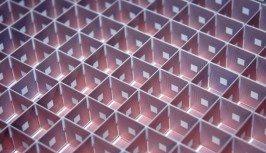A Lens for Magnetic Fields

Contactless charging of mobile devices is more convenient than fiddling around with power adapters, plugs and cables but the transmit and receive coils need to be in close physical contact otherwise power transfer losses become significant. A team of researchers in Duke's Pratt School of Engineering working with the Toyota Research Institute of North America have succeeded in creating an array of hollow cubes which act as a lens for low-frequency magnetic fields.
The lens is made up of cells with copper coils etched onto their walls. The geometry of these coils and their repeating nature form a metamaterial that interacts with magnetic fields in such a way that the transmitted fields become confined into a narrow cone where the power intensity is much higher than that of an unfocussed pattern.
"For the first time we have demonstrated that the efficiency of magneto-inductive wireless power transfer can be enhanced over distances many times larger than the size of the receiver and transmitter coils" said Yaroslav Urzhumov, assistant research professor of electrical and computer engineering at Duke University. "If your electromagnet is one inch in diameter, you get almost no power just three inches away, only about 0.1 % of what’s inside the coil." But with the ‘Superlens’ in place the magnetic field is focused nearly a foot away with enough strength to induce noticeable electric current in an identically sized receiver coil.
